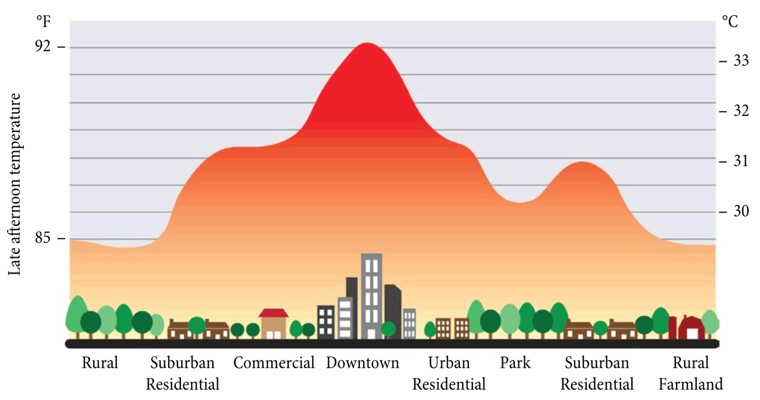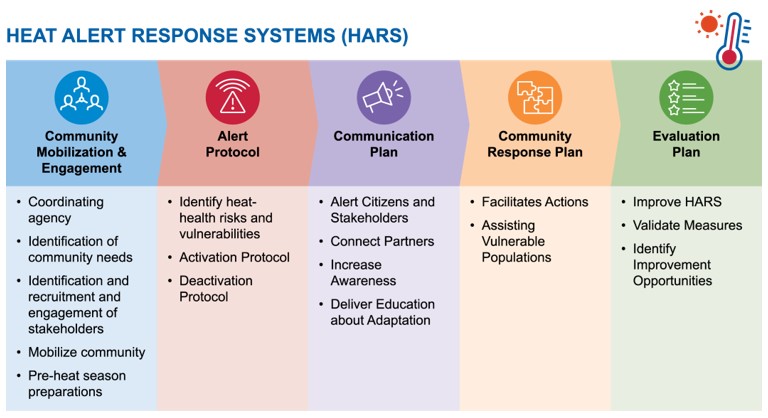Health risks from extreme heat exist and continue to grow in Simcoe Muskoka, impacting individuals and communities. Climate change is causing rising annual average temperatures and increasing the frequency and severity of extreme heat events.
The negative effects of extreme heat are preventable. Keeping people who live, work, and play in Simcoe Muskoka safe from extreme heat requires collaboration across multiple sectors, with roles from public health, local government, emergency management departments, community partners, and individuals.
This page provides practical information and resources to assist municipal partners with developing and implementing strategies (i.e., a Heat Alert and Response System) to reduce the risk of illness and fatalities during heat events.
Heat Impacts and Risks of Extreme Heat
Extreme heat has direct and indirect negative effects on the health and well-being of people and communities. Everyone can be affected by heat. However, the risks are not equal for everyone due to differences in levels of exposure, sensitivity, and access to resources. People can be more susceptible to heat-related health risks early in the heat season because they are not yet acclimatized to higher temperatures.
During an extreme heat event, the health risks and vulnerabilities can be amplified and compounded by other public health threats (e.g., COVID-19 pandemic, wildfires, extreme weather) and events (e.g., power outages) that occur at the same time or have recently happened.
Understanding how heat impacts communities and people's health, and who is at greater risk and why, can help inform which protective measures will be put in place.
Heat Islands
Due to the way urban environments are designed and built, they can have higher temperatures than surrounding and rural areas. This is referred to as the heat island effect, in which exposure to heat is magnified in urban areas. The graphic below illustrates the heat island effect across different environments.

Image Source: Figure 1 from Durham Region. 2018. Adapted from EPA. 2014
Heat Alert Response Systems
Municipalities can take preventative action to reduce the risk of extreme heat as well as develop and implement Heat Alert and Response Systems (HARS) to reduce the risk of illness and fatalities during heat events. A HARS puts in place processes to alert the public of heat events and provide information, resources, and supports to help individuals take protective actions before and during an extreme heat event, especially for those who are at greater risk of negative health effects due to heat.
A HARS includes five elements and related tasks, as depicted in the graphic below, that are shared by stakeholders, including local governments, public health, and community partners.

Heat Alert Response Systems ©2020 by Interior Health Authority. Adapted from Health Canada (2012). Used with permission.
NEW: Recommendations to municipalities in response to heat warnings (August 2022)
Strategies to Reduce Heat Exposure and Negative Health Outcomes
HARS is an important approach to reduce heat-related health risks during extreme heat events and is most effective when it is done together with preventative actions that provide long-term, sustainable protection from and resilience to heat and extreme heat. Preventative strategies provide protection from heat and extreme heat. They also provide a broad range of other health and economic benefits that support health and well-being of individuals and communities, providing a win-win situation.
Ontario's Harmonized Heat Warning and Information System
A Heat Warning and Information System (HWIS) is a coordinated provincial system that provides the criteria for issuing heat warnings in Ontario and is used in Simcoe Muskoka. A community's heat response plan is generally activated when specific criteria are met and Environment and Climate Change Canada (ECCC) issues a Heat Warning.
Climate Change Connection
In Simcoe Muskoka, climate change is leading to average rising temperatures, more hot days, and an increase in the frequency and severity of extreme heat events, resulting in greater health risks. Rising temperatures also influence other climate-related health hazards as vector-borne illnesses, food and water quality and quantity, drought, and wildfires.
Climate mitigation and adaptation strategies can effectively reduce the risk of extreme heat and climate-related hazards in the short and long-term. Climate action also protects and promotes health and well-being and provides economic savings for individuals, organizations, and governments.
Municipalities play a significant role in implementing climate action locally, and inspiring climate action by other levels of government, community partners, and the public.
Without greater adaptation efforts, projected increases in the frequency and severity of extreme heat and climate-events (e.g., extreme weather, drought, wildfires) will directly and indirectly affect health by causing more illness, injuries, and deaths. Immediate, rapid, and sustained climate mitigation is required to limit warming to 1.5ºC and associate risks to communities. Mitigation and adaptation work together to reduce risks of climate change. Often adaptation efforts have mitigation benefits and vice versa. Further, each approach helps reduce the cost of the other.
Resources
Provincial:
National and Cross-Provincial:
International: